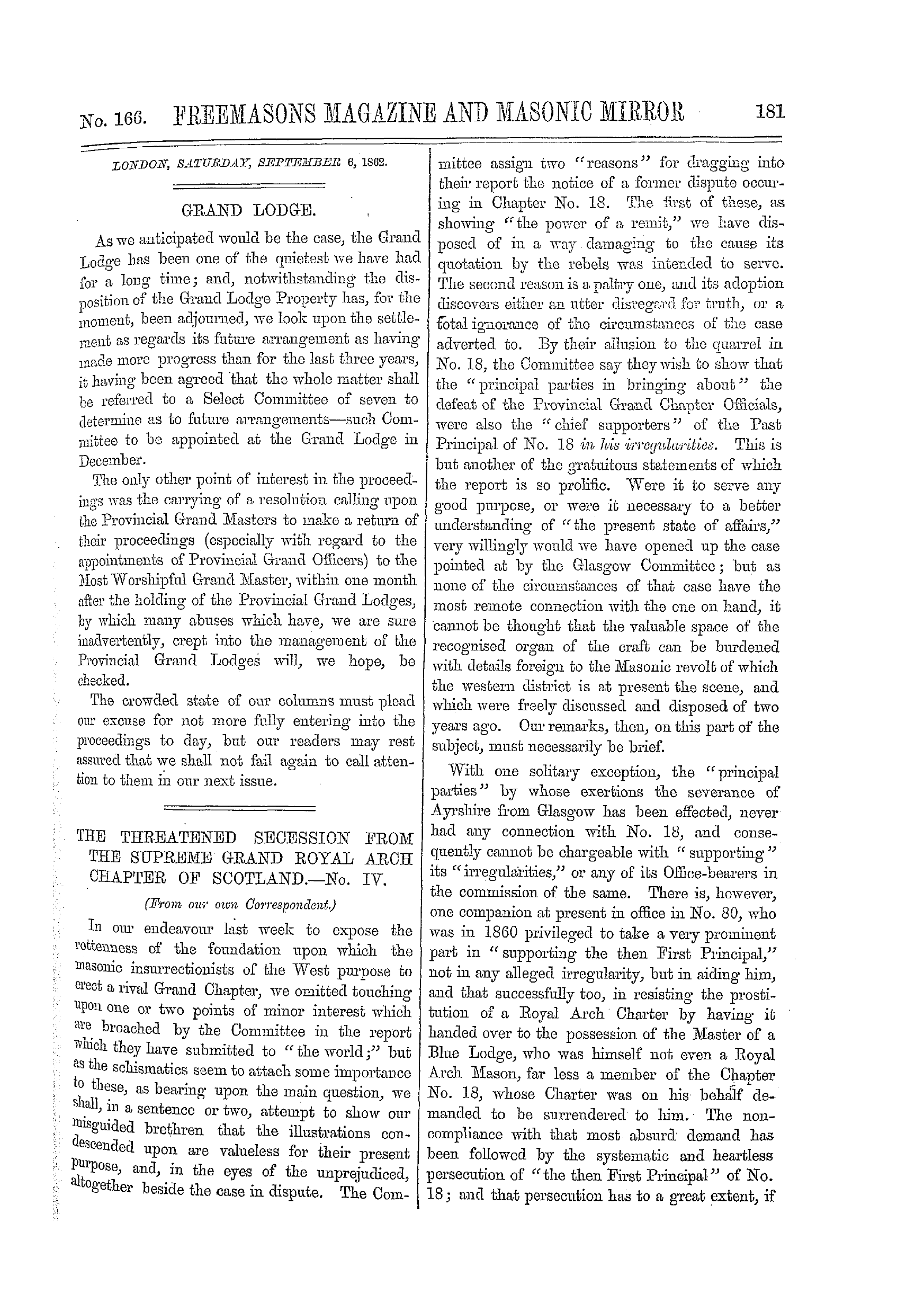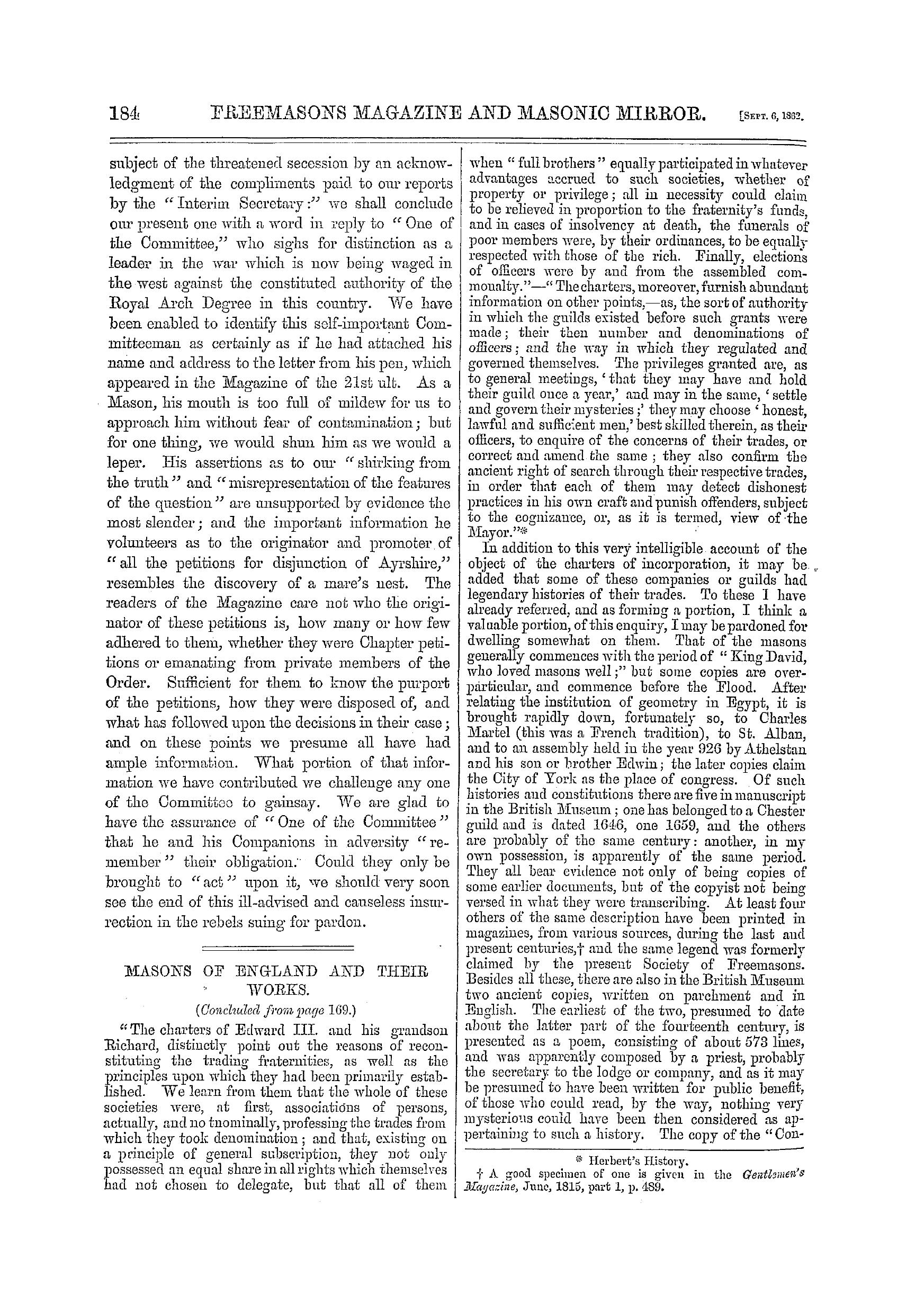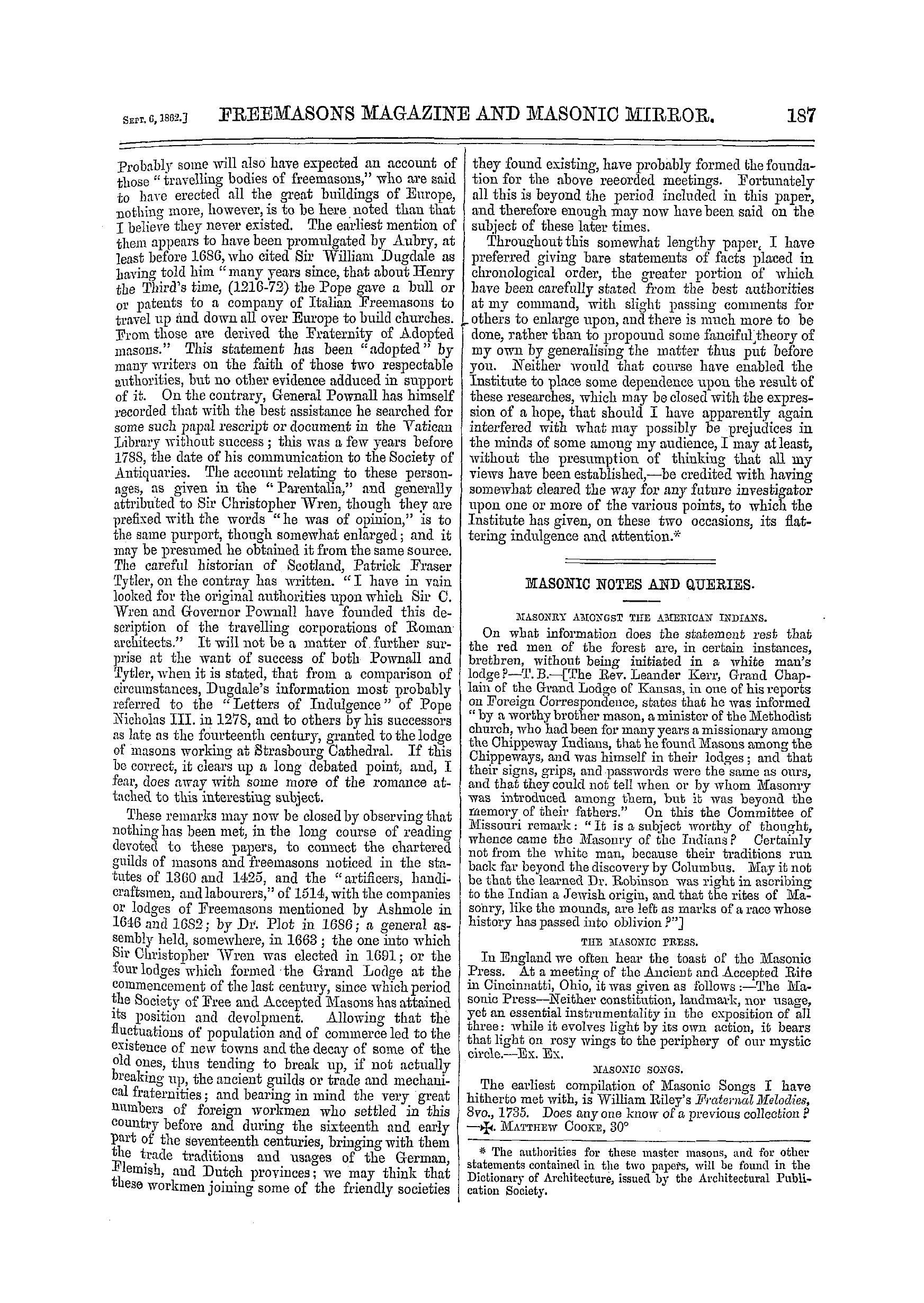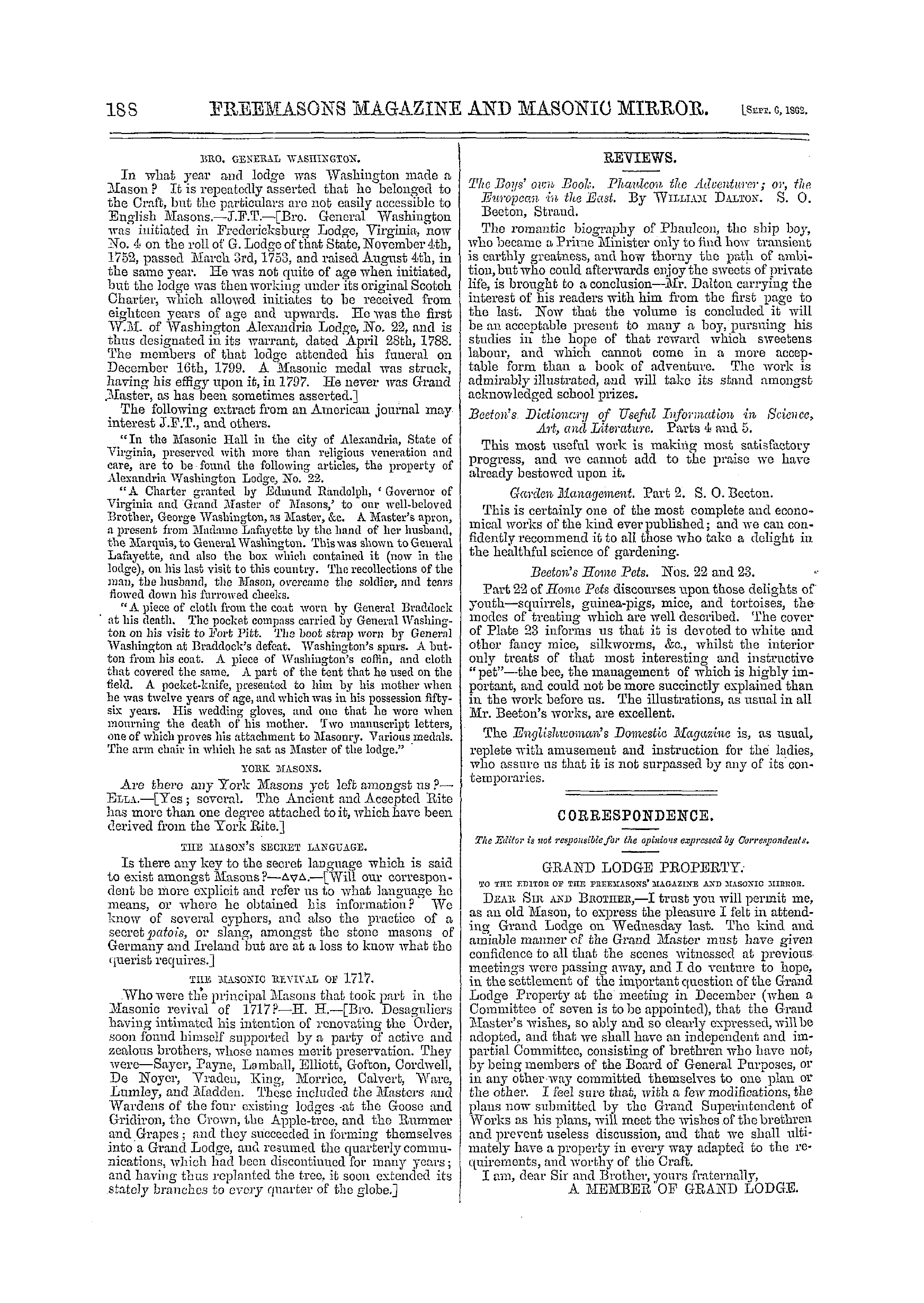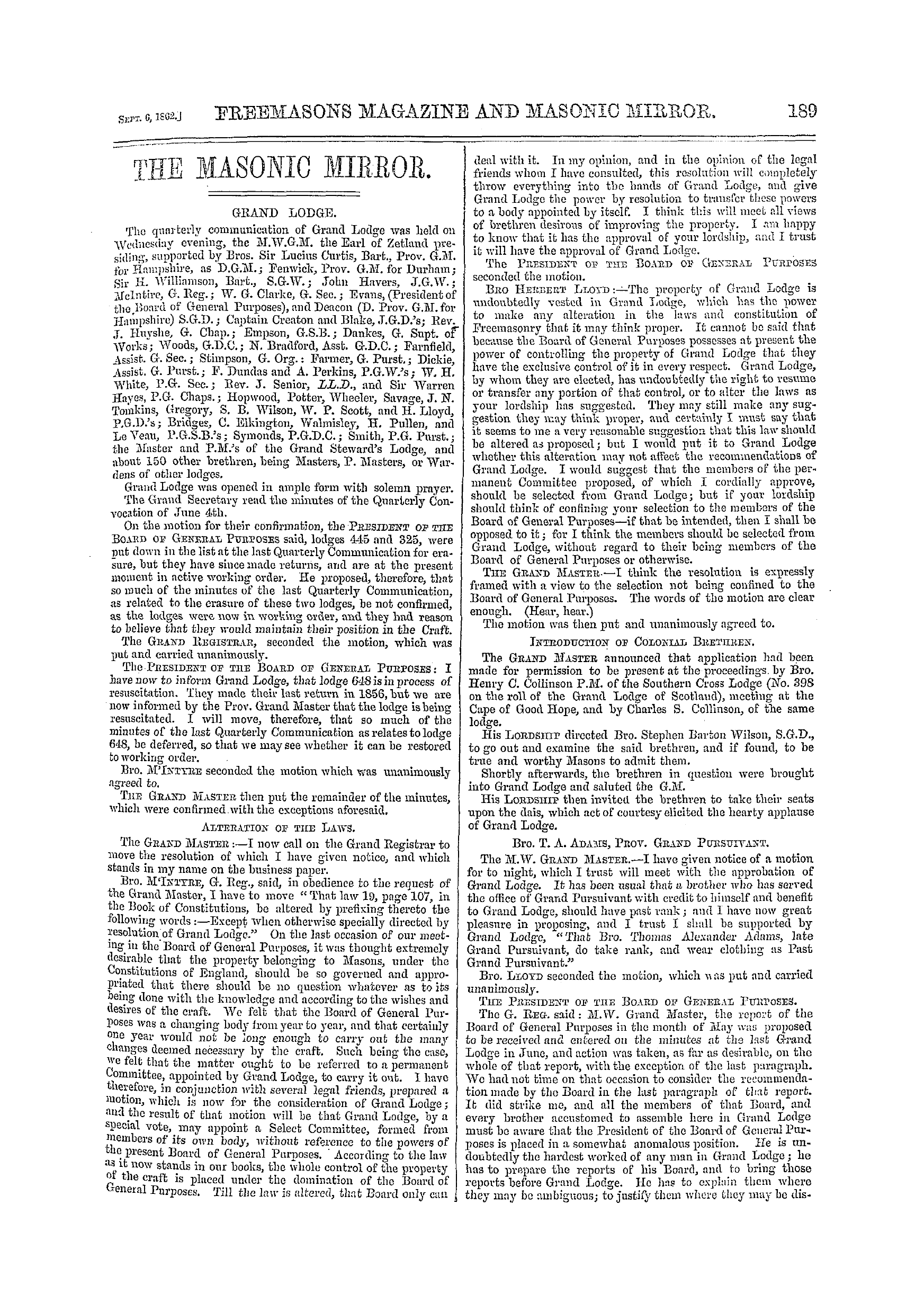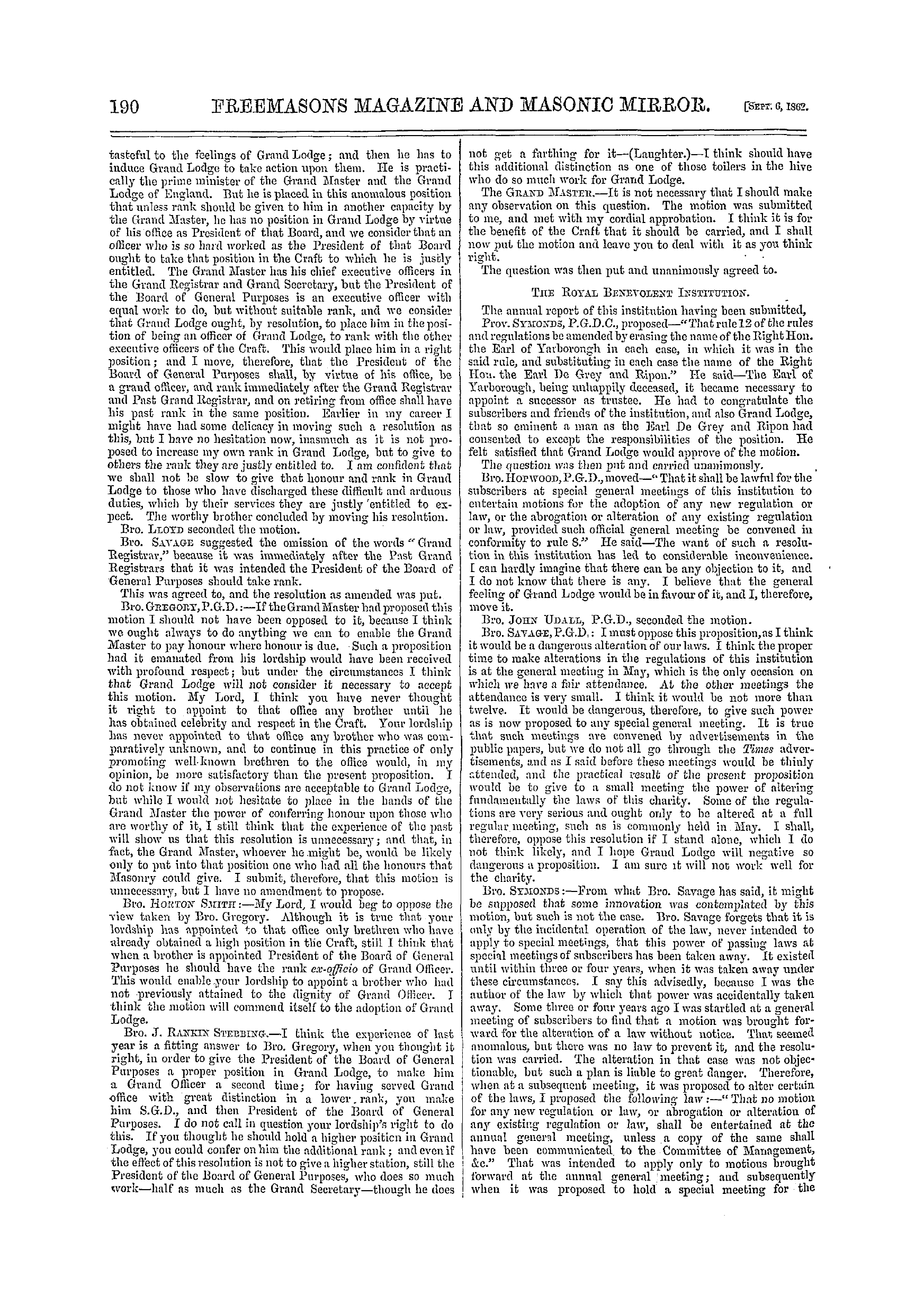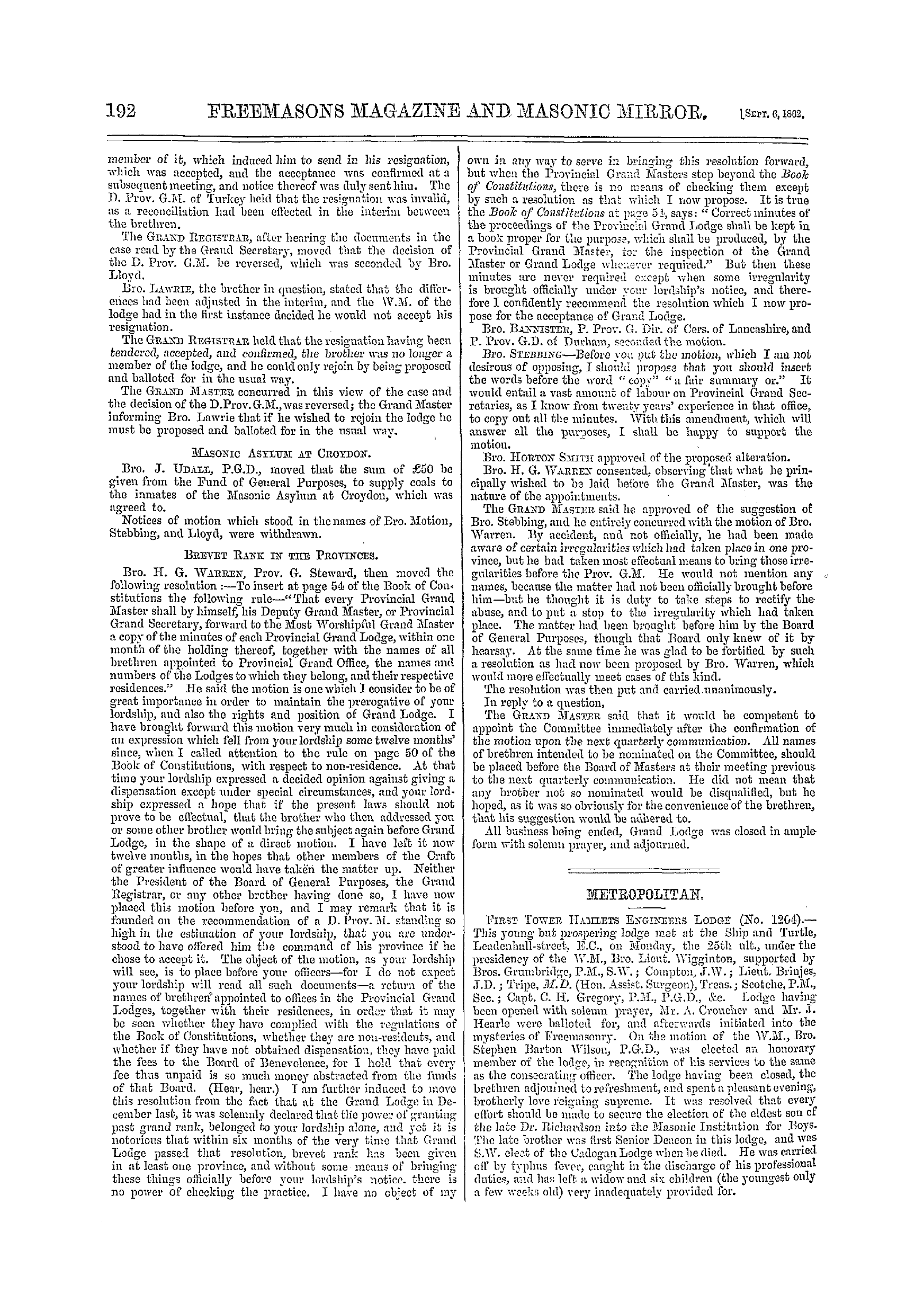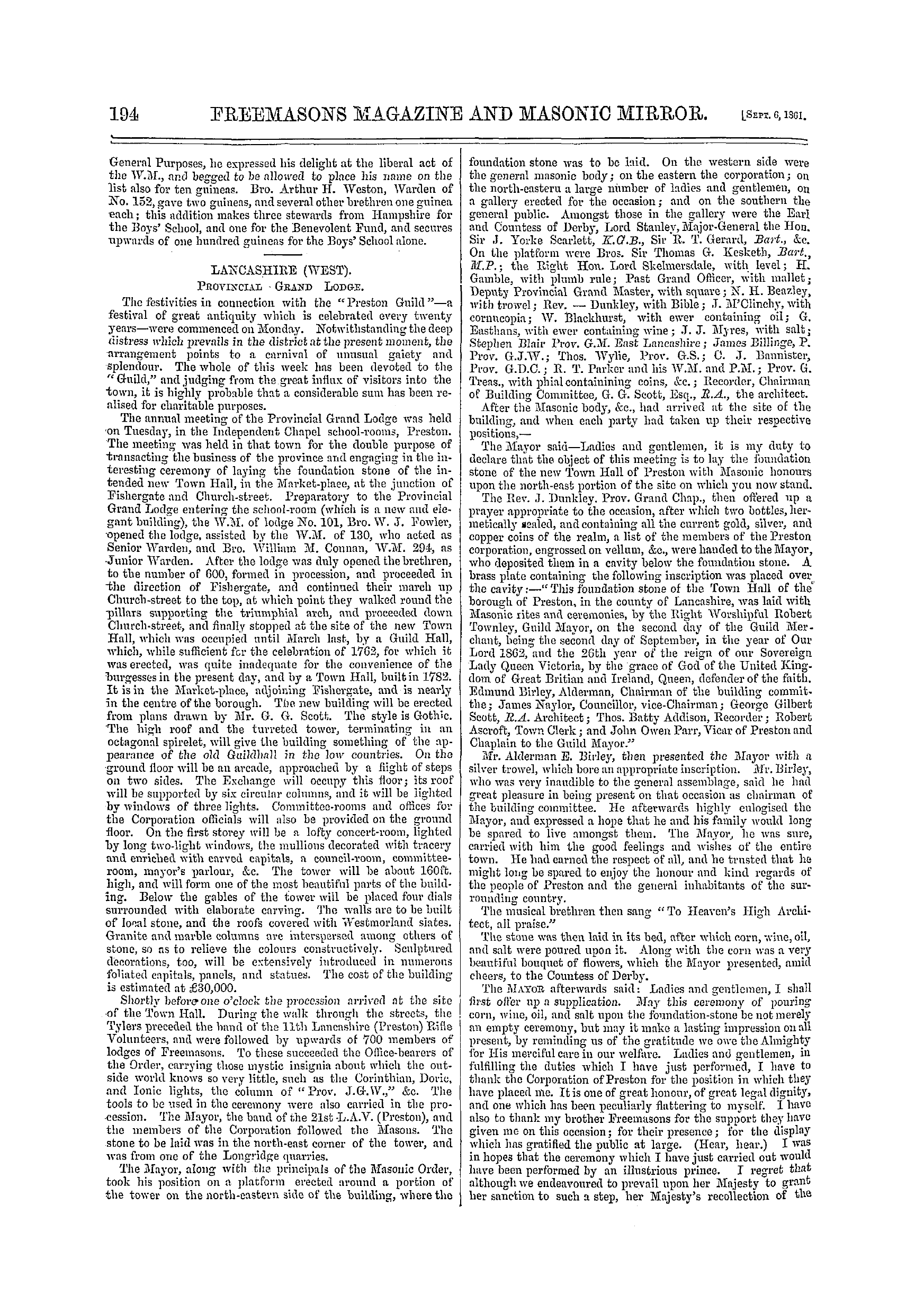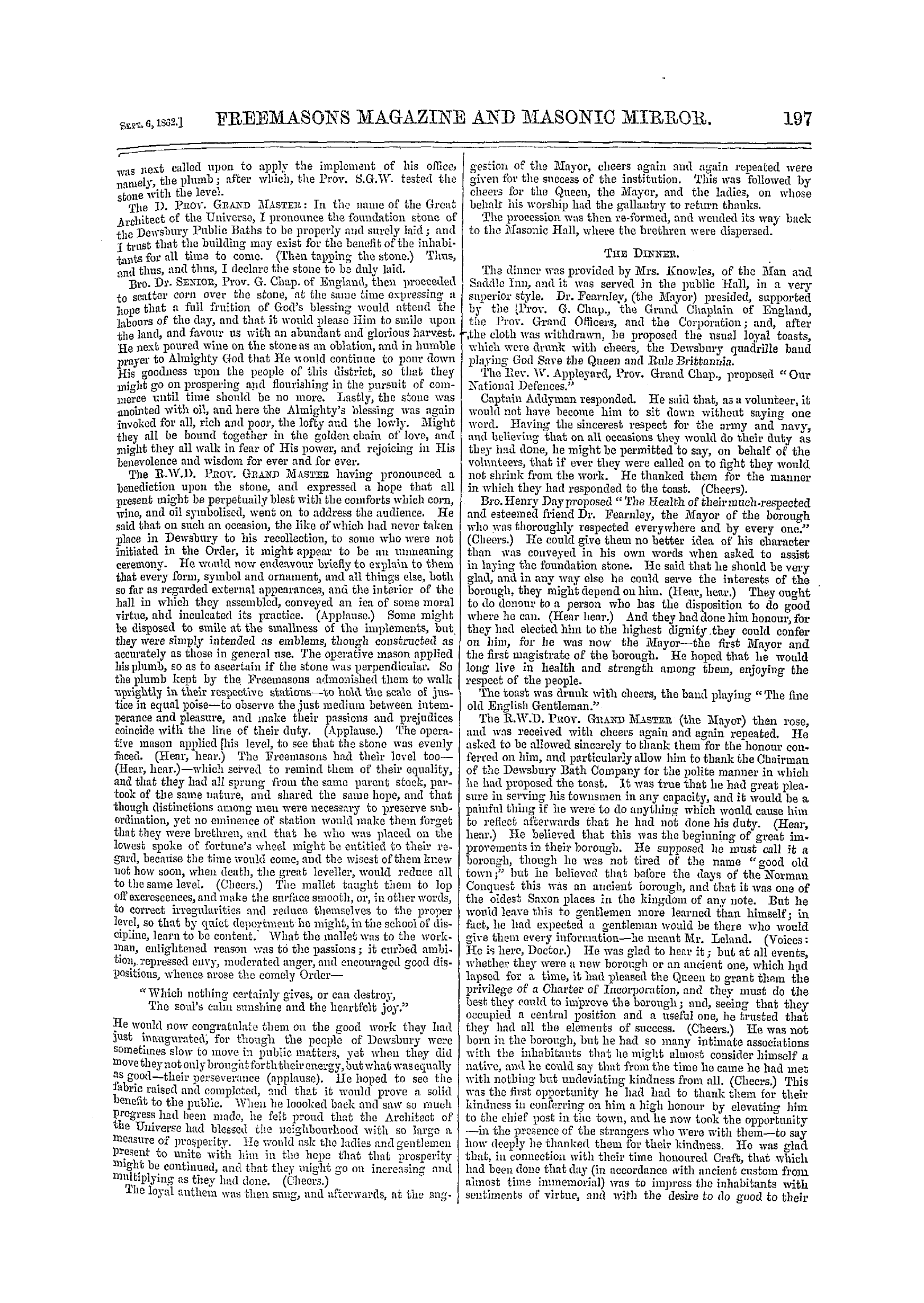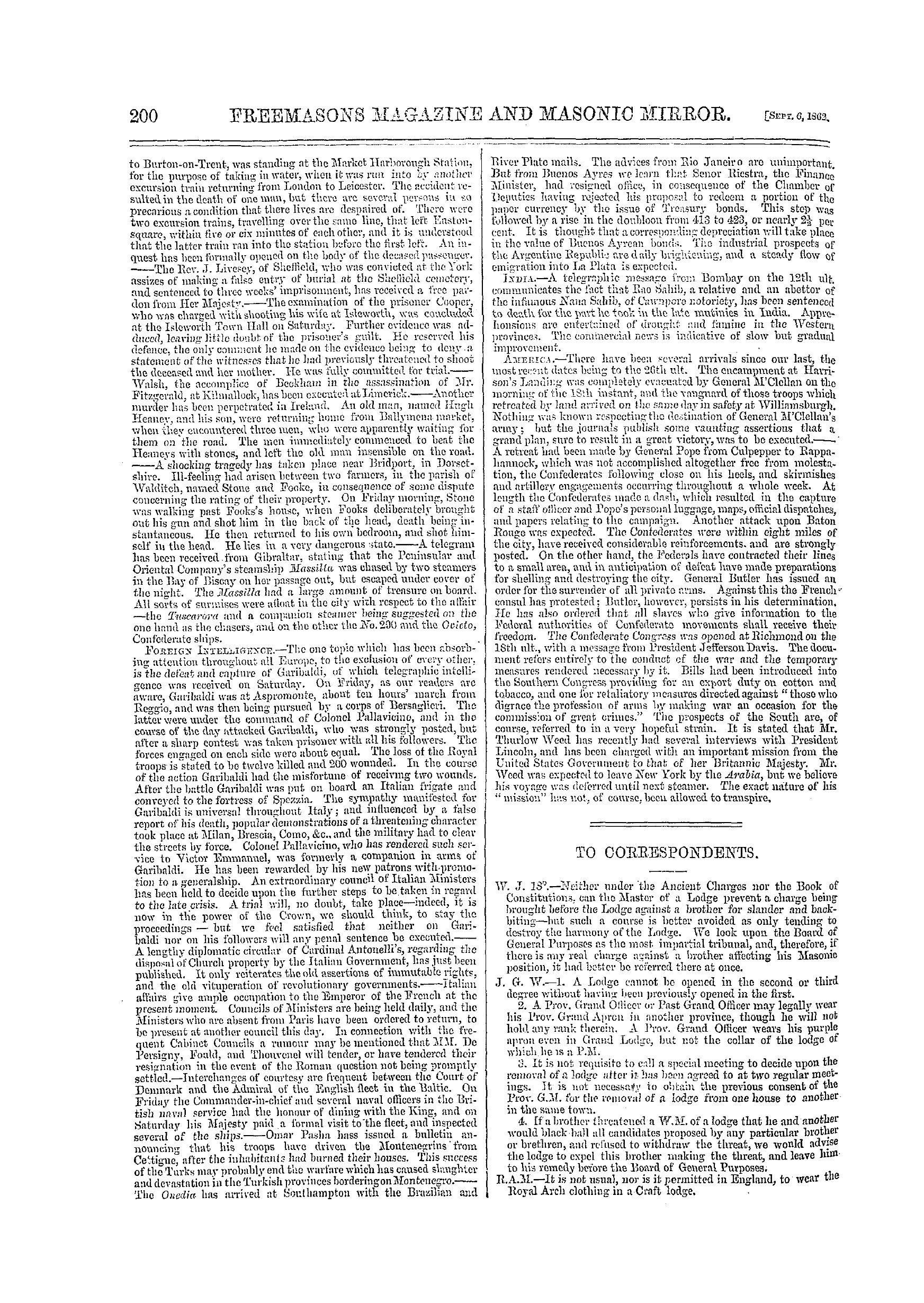-
Articles/Ads
Article MASONS OF ENGLAND AND THEIR WORKS. ← Page 3 of 4 →
Note: This text has been automatically extracted via Optical Character Recognition (OCR) software.
Masons Of England And Their Works.
( which Avould noAv , hoAvever applicable , be rather an awkivard compliment to a bishop ' s gamekeeper ) was then doubtless a title of honour—a gin is still , I think , " he continues , " technically called an engine or ingene . " Another exponent of the same document demonstrates that "this surname ( ingeniator ) was not uncommon in the north of England at the period ,
ancl Avas applied to any person who manifested genius in his vocation . " Howe \ er this may be , it Avas gratifying to meet Avith the plausible conjunction of these words " architectus" and "ingeniator , " as in the first enquiry but feiv instances of the application of the latter term could be given , although it Avas one of Avhich earliest mention was found . It will be needless to read in detail all the instances
of the use of the mason ' s designations ; those that have appeared to me to contain most interest Avill therefore only be noticed . " Caiinentarius" is naturally the earliest , 1077 , ancl is the term most constantly used . " Artifices" were collected at Canterbury to a consultation , from which William of Sens came out the " Magister" a term also applied to his successor
, William the Englishman ; but it is not clear whether "master of the work" or " master mason" is to be applied to these tivo . In 1217 , a popular educational writer noted the word " cementarii , " together Avith the old Erench synonym " maszun , " leaving little hesitation for our accepting the one for the other . * The
The London Assize of 1212 , besides " cementarii" has " sculptores lapidum hberorum , " words of very exceptional use . f "Artifices" were also assembled to a consultation at . the commencement of the building of Westminster Abbey . At the end of the thirteenth ancl beginning of the fourteenth centuries , the terms " magister cementarii , " Avith his " sociis , " or felloAvs ,
are obtained ; " marniorarius" has been noted ; also a new worcl " latomus , " Avhich is after that period found Avritten in all manner of spellings . ^ A " masoune " in old Erench , is to erect a house , " de pere fraunche ;" and of somewhat later date is found a " mestre mason de franche pere ; " Avhile still later , 1360 , a mason " cle fraunche pere ou cle grosse pere" appears in the
statutes . § During the fourteenth century , "lathomus " is constantly found , aud it Avould appear to be applied as often to the mason AVIIO was to execute cut-work as to the mason AVIIO Avas required for rougher Avork , or to labour at the quarry . Under the date of 1396 the contractors for the Avorks at Westminster Hall
were " citiens et masons de Londres ; " and of the same year is the passage "lathomos vocatos ffremaceons , " and "lathomos vocatos ligiers , " or as Ave should translate the words , masons called free ( stone ) masons and masons ( the same term is used for both ) called layers or setters . " Siineiitarius" before , and "fremason" after , 1396 , are found in the Babric Rolls of Exeter Cathedral . These entries shoAV the use of the latter term in Kent and Devonshire at the
same period . As remarked in the previous paper ^ "lathomus" is appended to William de Wynneford ' s portrait at Winchester College ; ancl someAvhat later ^ amongst the " latimi" at Durham , one is specifically called a " ffremason . " Thereafter , mason and freemason are terms in constant use doAvu to the present time . Erotn these details three facts are obtained ;
the first , that the earliest use of the English term freemason Avas in 1396 , Avithout any previous Latin word . The second is , that the Avord freestone , or its equivalent Latin term , had been employed from the beginning the previous century , i . e . 1212 ; * ancl the third factif that word be permitted meis that the
, , term freemason itself is clearly derived from a masou Avho worked freestone , in contradistinction to the mason AA'ho Avas employed iu rough Avork . This may appear to many a trivial point , but those AA'ho know the many fanciful origins of it so often quoted , will perhaps accept this solution ; one which has been
suggested before , Avithout any proof brought fonvard iu support of it . Besides these , two other terms of trade have been employed to ivhich it may be supposed there would
have been many references ; the one is , " magister lapicida , " the other , "liberi muratores . " Such designations ( I submit it Avith some trepidation ) are nowhere to be met in documents relating to England ; thus there is no sufficient authority for that constant use of them observable in Avriters of former years . There is yet another designation upon which much has
been AA-ritten , especially during the last one hundred years , namely , the "Eratres Pontis , " a brotherhood that , more especially in Eranee , is said to have been founded for the express purpose of travelling far and AA'ide to build bridges . Even as regards that country I have only found a notice of such a troop haA'ing
been formed at the building of the bridge at AA'ignon , ancl of that of St . Esprit , over the Ehone , during the twelfth ancl fourteenth centuries ( 1178-88 aud 1265-1369 ) . Not much surprise will therefore be felt Avhen it is stated as regards England , that amongst the numerous references in my notes concerning bridge
building especially , no intimation of any such institution appears , ! or that M . Gregoire , in his history of this brotherhood , could only refer to the bridge over the Dee , and another over the Eden , and those on the authority of the Annual Register for 1808 ,
Note: This text has been automatically extracted via Optical Character Recognition (OCR) software.
Masons Of England And Their Works.
( which Avould noAv , hoAvever applicable , be rather an awkivard compliment to a bishop ' s gamekeeper ) was then doubtless a title of honour—a gin is still , I think , " he continues , " technically called an engine or ingene . " Another exponent of the same document demonstrates that "this surname ( ingeniator ) was not uncommon in the north of England at the period ,
ancl Avas applied to any person who manifested genius in his vocation . " Howe \ er this may be , it Avas gratifying to meet Avith the plausible conjunction of these words " architectus" and "ingeniator , " as in the first enquiry but feiv instances of the application of the latter term could be given , although it Avas one of Avhich earliest mention was found . It will be needless to read in detail all the instances
of the use of the mason ' s designations ; those that have appeared to me to contain most interest Avill therefore only be noticed . " Caiinentarius" is naturally the earliest , 1077 , ancl is the term most constantly used . " Artifices" were collected at Canterbury to a consultation , from which William of Sens came out the " Magister" a term also applied to his successor
, William the Englishman ; but it is not clear whether "master of the work" or " master mason" is to be applied to these tivo . In 1217 , a popular educational writer noted the word " cementarii , " together Avith the old Erench synonym " maszun , " leaving little hesitation for our accepting the one for the other . * The
The London Assize of 1212 , besides " cementarii" has " sculptores lapidum hberorum , " words of very exceptional use . f "Artifices" were also assembled to a consultation at . the commencement of the building of Westminster Abbey . At the end of the thirteenth ancl beginning of the fourteenth centuries , the terms " magister cementarii , " Avith his " sociis , " or felloAvs ,
are obtained ; " marniorarius" has been noted ; also a new worcl " latomus , " Avhich is after that period found Avritten in all manner of spellings . ^ A " masoune " in old Erench , is to erect a house , " de pere fraunche ;" and of somewhat later date is found a " mestre mason de franche pere ; " Avhile still later , 1360 , a mason " cle fraunche pere ou cle grosse pere" appears in the
statutes . § During the fourteenth century , "lathomus " is constantly found , aud it Avould appear to be applied as often to the mason AVIIO was to execute cut-work as to the mason AVIIO Avas required for rougher Avork , or to labour at the quarry . Under the date of 1396 the contractors for the Avorks at Westminster Hall
were " citiens et masons de Londres ; " and of the same year is the passage "lathomos vocatos ffremaceons , " and "lathomos vocatos ligiers , " or as Ave should translate the words , masons called free ( stone ) masons and masons ( the same term is used for both ) called layers or setters . " Siineiitarius" before , and "fremason" after , 1396 , are found in the Babric Rolls of Exeter Cathedral . These entries shoAV the use of the latter term in Kent and Devonshire at the
same period . As remarked in the previous paper ^ "lathomus" is appended to William de Wynneford ' s portrait at Winchester College ; ancl someAvhat later ^ amongst the " latimi" at Durham , one is specifically called a " ffremason . " Thereafter , mason and freemason are terms in constant use doAvu to the present time . Erotn these details three facts are obtained ;
the first , that the earliest use of the English term freemason Avas in 1396 , Avithout any previous Latin word . The second is , that the Avord freestone , or its equivalent Latin term , had been employed from the beginning the previous century , i . e . 1212 ; * ancl the third factif that word be permitted meis that the
, , term freemason itself is clearly derived from a masou Avho worked freestone , in contradistinction to the mason AA'ho Avas employed iu rough Avork . This may appear to many a trivial point , but those AA'ho know the many fanciful origins of it so often quoted , will perhaps accept this solution ; one which has been
suggested before , Avithout any proof brought fonvard iu support of it . Besides these , two other terms of trade have been employed to ivhich it may be supposed there would
have been many references ; the one is , " magister lapicida , " the other , "liberi muratores . " Such designations ( I submit it Avith some trepidation ) are nowhere to be met in documents relating to England ; thus there is no sufficient authority for that constant use of them observable in Avriters of former years . There is yet another designation upon which much has
been AA-ritten , especially during the last one hundred years , namely , the "Eratres Pontis , " a brotherhood that , more especially in Eranee , is said to have been founded for the express purpose of travelling far and AA'ide to build bridges . Even as regards that country I have only found a notice of such a troop haA'ing
been formed at the building of the bridge at AA'ignon , ancl of that of St . Esprit , over the Ehone , during the twelfth ancl fourteenth centuries ( 1178-88 aud 1265-1369 ) . Not much surprise will therefore be felt Avhen it is stated as regards England , that amongst the numerous references in my notes concerning bridge
building especially , no intimation of any such institution appears , ! or that M . Gregoire , in his history of this brotherhood , could only refer to the bridge over the Dee , and another over the Eden , and those on the authority of the Annual Register for 1808 ,
